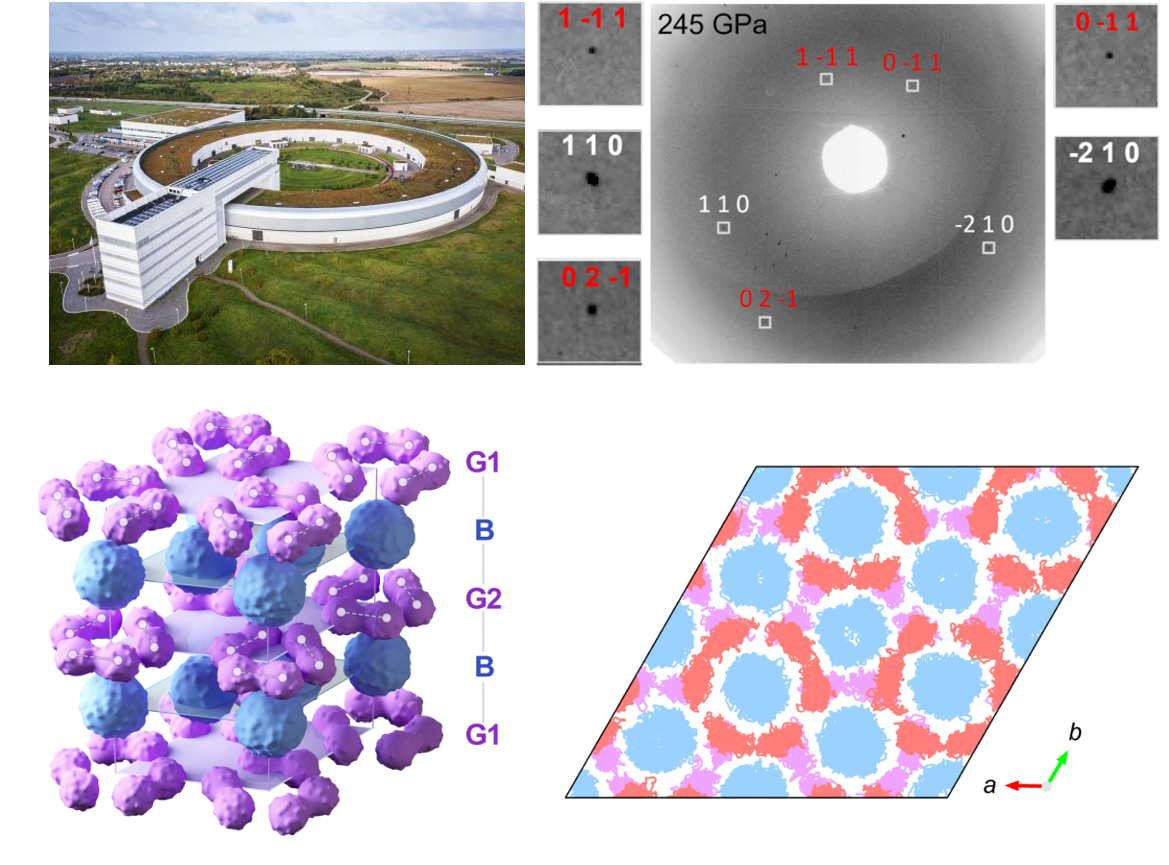
Metallic hydrogen is one of the central topics in high-pressure science. Producing metallic hydrogen is extremely challenging, requiring pressures above 400 GPa, which is the pressurelimit of the conventional diamond anvil cell techniques. While there are claims of producing metallic hydrogen at pressures between 400 GPa and 500 GPa, the crystallographic characterizations of hydrogen at those extreme pressures remained an mission impossible. Recently, a research team led by Dr. Ho-kwang Mao and Dr. Cheng Ji from HPSTAR made a breakthrough in the ultrahigh pressure crystallography of hydrogen techniques. By developing advanced synchrotron nano-probe based single crystal X-ray diffraction techniques, they provide direct crystallographic evidences showing that phase IV (above two million atmosphere pressures) of hydrogen transforms to a lower symmetry structure with a 6 times larger unit cell. This discovery suggests that hydrogen is going through a polymerization process by molecular associations under strong compression. This work offers new insights into the metallization pathway of hydrogen and establishes a reliable experimental method for directly determining metallic hydrogen’s crystal structure. This finding has been recently published in NATURE.
As the first element in the periodic table, hydrogen is extraordinary. It is the oldest element and the most abundant element in the cosmos. Its simplest atomic and electronic structure provided the basis for theoretical modeling and played a vital role in the developments of quantum mechanics. Under normal conditions, hydrogen exists as a gas, but under extreme pressures, it crystallizes into a solid. Theoretical predictions suggest that hydrogen may transform into a metal with novel properties, such as room-temperature superconductivity, and an exotic quantum state with concomitant superconducting and superfluidic properties. However, synthesizing and experimental characterizations of metallic hydrogen remain one of the most formidable challenges in modern high pressure science. Among the different characterization techniques, crystal structure determination is one of the most difficult one. The reason is straight-forward. Under very high pressure, X-ray diffraction (XRD) is the only viable way to probe the crystal structure of hydrogen. Meanwhile, hydrogen has only one electron to generate XRD signal, thus being the hardest material to probe among all materials. The chance for crystallography study of dense hydrogen at ultrahigh pressure relies solely on the development of advanced techniques.
The research team, led by Dr. Mao and Dr. Ji collaborated with major synchrotron light sources globaly, including the Shanghai Synchrotron Radiation Facility (SSRF), Germany’s Petra III (DESY), and Sweden’s MAX IV Laboratory (Lund University) to develop ultrahigh-pressure synchrotron X-ray single-crystal diffraction (SCXRD) techniques. By those technical advances, they successfully captured SCXRD data of hydrogen above 2 million atmospheres (phase IV), revealing a structural transition from a simple hexagonal close-packed (hcp) phase to a post-hcp structure with larger unit cell and lower symmetry. The finding is similar to the previous results (Nature 573, 7775, 2019) in that the data satisfy a hcp-like lattice. The key difference is that in the new SCXRD data, very weak Bragg peaks which can only be explained by the existence of a supercell were unambiguously found by the guide of the UB matrix given by the SCXRD data. This is a first time proof that the modern high pressure crystallographic techniques are able to resolve complex crystal structure of hydrogen besides the hcp structure. To interpret these structural changes in more details, Professor Hanyu Liu from Jilin University conducted advanced computational simulations and revealed that hydrogen phase IV transforms into a mixed-layer arrangement, with one layer exhibiting a graphene-like configuration, indicating a trend of polymerization by molecular associations.
Direct crystallographic evidence of hydrogen polymerization holds profound implications for understanding the metallization pathway. At the birth of the concept, Nobel laureate Eugene Wigner predicted that hydrogen, under high pressure, turns into a metal with a body-centered cubic structure akin to alkali metals. While, modern theories proposed more complex configurations for metallic hydrogen, including a superconducting superfluid liquid state. The discovery of hydrogen polymerization suggests that metallization may not be dissociation but rather a step-wise polymerization through enhanced intermolecular interactions. Ultimately, metallic hydrogen’s properties will be dictated by its unique crystal structure, and the newly developed experimental and theoretical methods pave the way for unraveling this mystery.

Caption: World’s first 4th generation synchrotron source (MAX IV) in Sweden (upper left,credit:Johan Persson), representative SCXRD data of hydrogen (upper right,adapted from Fig. 1f), schematic of crystal structure of phase IV (lower left,adapted from Fig. 3a), path integral molecular dynamics simulations of phase IV (adapted from Fig. 3b).
--------------------
Media report:
Deutsches Elektronen-Synchrotron DESY
近日,北京高压科学研究中心的毛河光院士和吉诚研究员领衔的科研团队在超高压氢晶体学研究领域取得突破。通过开发基于同步辐射纳米探针的单晶X射线衍射技术,研究团队首次通过晶体学数据证明了氢的高压相转变为非六方密堆积的复杂晶体结构,表明氢的第IV相在对称性降低的同时晶胞体积扩大六倍。通过与吉林大学的理论研究团队进行合作,揭示了氢在强压缩条件下通过分子间作用力的增强发生聚合的物理过程。该研究不仅为氢的金属化路径提供了新的认知,同时建立了直接测定金属氢晶体结构的可靠实验方法,为揭开金属氢晶体结构的神秘面纱做好了铺垫。相关结果以’’Ultrahigh pressure crystallographic passage towards metallic hydrogen‘’为题发表在《Nature》期刊上。